The iPhone 4 Redux: Analyzing Apple's iOS 4.0.1 Signal Fix & Antenna Issue
by Brian Klug & Anand Lal Shimpi on July 15, 2010 12:28 PM EST- Posted in
- Smartphones
- Apple
- iOS 4
- iPhone 4
- Mobile
In case you haven’t noticed, the iPhone 4’s antenna design has come under considerable scrutiny. In our iPhone 4 review, we investigated the iPhone 4 antenna and came to two conclusions. First, that iOS 4 was displaying signal bars in an overly optimistic manner, compressing the dynamic range of possible signal bars users can see. Second, we identified a worst case signal drop of around 24 dB when the iPhone 4 is cupped tightly in the left hand, covering the black strip and possibly detuning the antennas and adding additional attenuation from the presence of the hand.
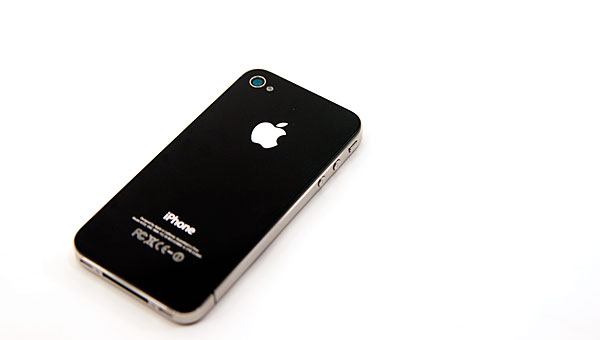
Since those initial measurements, we’ve been working tirelessly to both characterize the problem, fully understand the mechanisms behind it, and report on a number of possible solutions.
The Bars Have Changed
On July 2, Apple released a letter noting that the formula used in iOS 4.0 to calculate how many bars are presented for each signal strength is “totally wrong.” This mirrored our conclusions that the effects of the signal drop were exacerbated in part by the way the iPhone visualizes signal strength - the dynamic range is compressed so much that the 24 dB drop from cupping the phone without a case could make all the bars go away.
They went on to promise that in a future software update they would make bars 1, 2, and 3 taller, and make the bars more “accurate” by displaying 2 bars fewer in certain circumstances.
iOS 4.1 beta rolled around yesterday, and we immediately dove in to find out just how much the bar to signal strength mapping has changed. Update: iOS 4.0.1 final just came out this afternoon and we finished preliminary testing. The signal strength mapping algorithms are identical to the 4.1 beta. The findings in this article apply to 4.0.1 as well as the 4.1 beta.

After updating our devices to the iOS 4.1 beta (and 4.0.1) and making sure our little trick to show signal strength in dBm instead of bars still worked, we set off. Remember last time how I said I drove around town all day with iOS 4.0, testing the phone, and recording signal strength and how many bars were being shown? You guessed it - another update, another evening of driving around. Anand and I did quite our fair share of moving around to get a complete picture of what the new cutoffs are.
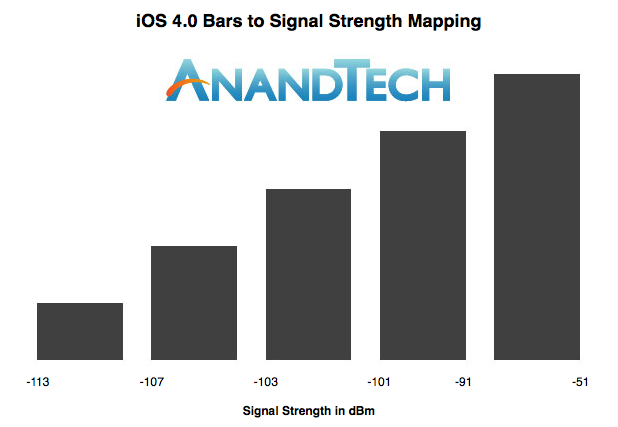
Old Bars
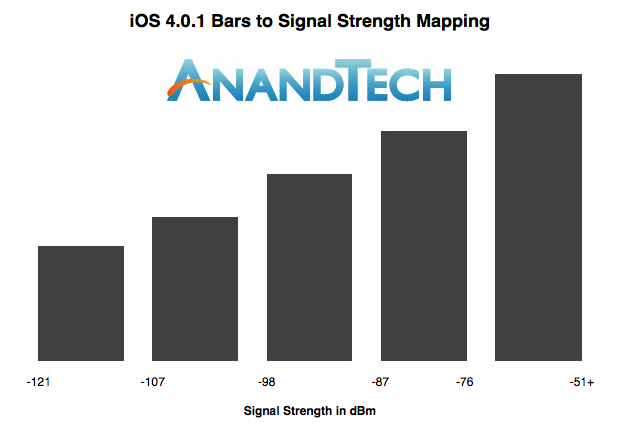
New Bars
The results are conclusive - Apple has dramatically changed the signal strength to signal bar mapping in iOS 4.0.1 and the iOS 4.1 beta, making the dynamic range not only much broader, but the range values for each bar much wider. The range of signals that correspond to bars three and four are the same width, and bar two is only slightly less.
The cutoff value for two bars to one bar remains the same, but every other value has increased. The result is that the worst case drop of 24 dBm no longer makes all the signal bars disappear, but rather two.
AnandTech reader Mike Escoffery, Director of Design and User Experience at Media Platforms, created his own diagram to help compare the old and new way of iOS signal strength reporting:
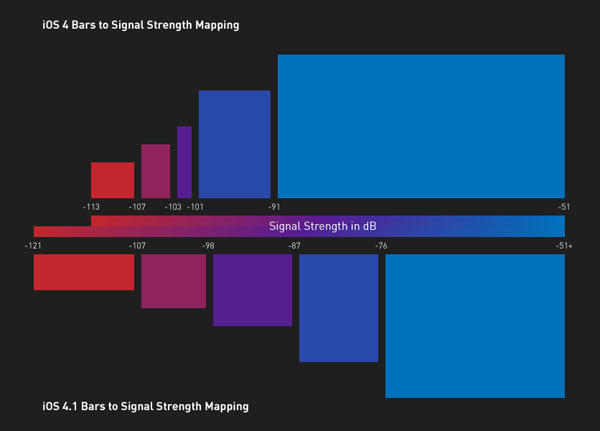
As you can see the old way (top) put far too much weight into the 5th bar of signal. Apple's new approach not only splits it up more reasonably between the 4th and 5th bar (still non-linearly keeping you in the 5th bar if possible) but also extends the range of the lower bars.
This change actually presented itself in our numeric signal strength reports - there’s more dynamic range in these numbers too. Previously, the absolute lowest value any iPhone would report was -113 dBm. With iOS 4.0.1/4.1, the value is now a shockingly low -121 dBm. In the iPhone 4 review, I talked a lot about how although the phone is prone to dropping signal from being held wrong, it was measurably more sensitive in weak signal areas. I was shocked that calls and data worked seemingly unfazed at -113 dBm. It seems as though this increased 8 dBm of range below -113 dBm was meant to show really how much more sensitive the radio stack is - it undeniably is more sensitive. Both Anand and I were able to hang onto calls all the way down at -121 dBm.
We’ve also included a comparison to how the latest version of Android displays signal bars from GSM or UMTS networks below. Thankfully, this didn’t require driving around town all day but rather inspecting the latest version of the Android source code from Google’s own repositories. Android uses an ASU value to compute signal strength, which isn’t anything more than a remapping of dBm to a sane value that’s a bit easier to interpret.
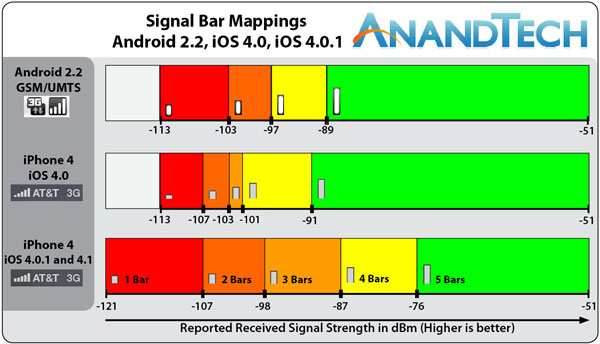
Apple’s mappings have gone from having probably the most compressed dynamic range among handset vendors to less compressed than Android.
While the software update obviously does not and cannot address the design of the antenna itself - or make the drop from holding the phone any less - it does change the way the issue is perceived among users. The result is that most iPhone users will see fewer bars disappear when they hold the iPhone 4 in a bare hand. The side effect is that the iPhone now displays fewer bars in most places, and users that haven’t been reporting signal in dBm will time see the - perhaps a bit shocking - reality of locations previously denoted as having excellent signal.
Interestingly enough, Apple has indeed changed the heights of bars 1, 2, and 3. They’re taller, and the result is that the relative heights are no longer linear, but rather a tad exponential looking. It’s a mind trick that Apple no doubt hopes will make the signal look better. If the bars are taller, they must denote stronger signal, right?
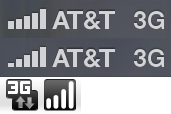
From top to bottom: iOS 4.1, iOS 4.0, Android 2.2
The reality is that Apple likely wants to deflect at least some of the initial backlash AT&T will face for reporting the signal bars without any concessions. Concessions that used to make coverage look better than it really is. Regardless of how tall the bars are, there are still going to be fewer of them virtually everywhere. Interestingly enough, while bars 1 and 2 are the most changed, their respective cutoffs are virtually unchanged.
While I was testing iOS 4.0.1, I told Anand that the signal reporting lie that started with the iPhone 3G had been removed entirely. That iOS 4.0.1 would potentially show the reality of AT&T’s coverage to iPhone users. With 4.0.1 users looking at signal bars will get a much more realistic view of how signal is changing.
We tested the iOS 4.1 beta on iPhone 3GSes as well, and found the mappings to be the same there as well.










146 Comments
View All Comments
screensurfer - Saturday, July 17, 2010 - link
No. Care to explain? It's not my words, it's his (something like this): "we haven't found a solution to defy the laws of physics. YET!", i.e., after September 30th we'll have a different antenna system that doesn't drop calls so easilybarelyinaudible - Saturday, July 17, 2010 - link
I keep seeing this article quoted as "proof" to apple's signal problem. However, I am finding that you are leaving out one rather important piece of information -- Your reference.Are you measuring in dBc, dBJ, dBm, dBi, dBd, dBq? There are literally hundreds of different reference points to choose from?
Also, dB is a logarithmic function - What is starting point for the attenuation? 100 dB? 30 dB?
Going from 120 - 100 dB is a MUCH MUCH bigger drop than from 30 - 10 dB -- since dB increases exponentially.
I think this article is being intellectually dishonest by not providing proper information to your readers (read: 85% of statistics are made up on the spot.)
ameridian - Saturday, July 17, 2010 - link
There are 22 occurrences in this article referrings to dBm's as the unit of measure. I'd advise reading the article before posting comments.leeseng - Saturday, July 17, 2010 - link
Hi anand,Full tight grip is about tight grip with another palm cover up the phone as well. That's very similar to how a tight-grip-fellow talking over the phone call.
I just did a test. Full-tight-grip cost -24dBm in my htc desire. Where as tight grip cost -12dBm. What about iPhone4?
rushbc - Saturday, July 17, 2010 - link
my favorite quote from the article is this one:"Ultimately this is why I consider Apple’s design here to be unnecessarily risky. Introducing a change with stylistic and technical benefits where the downside is limited but potentially very noticeable is just ballsy."
i agree and would like to add the following:
so is creating and mass-producing a $700 smartphone out of glass!!
that is pure Steve Jobs "balls to the wall, damn the torpedos, full speed ahead, F 'em if they don't like it" ballsy. love ya, Steve (and J.Ive), but you guys may be a little too aggressive sometimes in your design decisions.
i love my iphone 4, it's great, it's fast, it's beautiful, it works super for ALL of my needs--yes even phone calling/signal strength is great--but i am in constant fear of dropping it. dropping a $700 piece of glass would suck, because, guess what? glass breaks when you drop it!
...but try not dropping something that you carry around with you every single day, wherever you go, and are constantly using it throughout each day, picking it up, putting it down, taking it out of pocket, putting it back in pocket, etc. not an easy task....it requires constant care and vigilance to not drop the darn thing. and yes, glass can be slippery, so theres that, too.
love the phone, hate the stress!
Griswold - Saturday, July 17, 2010 - link
Get one of the free bumpers. It would be the first I'd do with a glass sandwich like that.ajb - Saturday, July 17, 2010 - link
I notice that in the photos of the iPhone 4 compared to the 3GS you were holding the iPhone 4 in your left hand (presumably having much more contact with the sensitive area of the antenna aray) while the photo of the 3GS depicts you holding the phone in your right hand. Could this have resulted in whole or in part for the larger drop of signal strength with the iPhone 4? Trust me, I'm not trying to defend the iPhone 4 - I've had enough problems of my own with maintaining a signal. I only ask to make sure that the numbers quoted are accurate.Also, I have noticed a very discernable difference in wi-fi performance at the weak end of the wi-fi bar scale (2 out of 3 wi-fi bars). My 3GS did much better in performance than does my 4. I sometimes get the impression that the phone's alogorithm at that wif-fi signal strength can't make up its mind whether it wants to be on 3G or wi-fi, which even with 2 bars should be and with the 3GS always was much faster than 3G. I do believe I read somewhere that there might be a problem with not releasing expired IP addresses, but I don't think that accounts for all of the problems I have been having because even after turning off wi-fi, moving closer to my wireless router, turning wi-fi back and, and walking back to where I originally was, I continue to experience the problem. Have you done any wi-fi testing? Do you have any insights into this problem? Any idea if this is a wide-spread problem?
codeachrome - Saturday, July 17, 2010 - link
Try KaptonTape.comanandreader - Sunday, July 18, 2010 - link
Brian-Could you clarify what you did there?
I'd like to enable dBm instead of bars on my iPhone.
Thanks!
Fri13 - Sunday, July 18, 2010 - link
"While the software update obviously does not and cannot address the design of the antenna itself - or make the drop from holding the phone any less - it does change the way the issue is perceived among users. "Actually the algorithm should effect the reception. The firmware (where the algorithm is placed) is responsible to use more or less power (W) to boost the signal what phone antenna is receiving. I have heard that max output is 2W. With 1W boost you gain -30dB.
While the bars tells the signal strength from cellphone to tover, the algorithm needs to compensate the drop/rise of the signal strength so it would not drop off. So if the max drop of is -24dB and before the iOS 4.0.1 the 1-4 bars were merely calculating -22dB range before drop out, the boost was never enough to keep the cellphone in the network (like you had -22dB signal, you touched and you got -24dB drop and algorithm boosted only -15dB, you were -7dB over the needed signal strength).
As anandtech has noted, software can not affect the hardware itself. The software can not eliminate the -24dB drop what is coming from hand (and touch). But the software can make the drop smaller by boosting the signal to needed level.
What is the needed level? Stronger signal = bigger power consuming -> less talk time / stand-by time. Needed level is simply that what gives good enough voice quality and keeps data transfer at maximum. It is not wise to overrun the power use so the battery is empty more faster.
And do people remember when Apple did improve the battery life in the 3Gs time with software patch? That would be very easy to do just by making the signal boost algorithm such that it does not use so much power = weaker boosting.